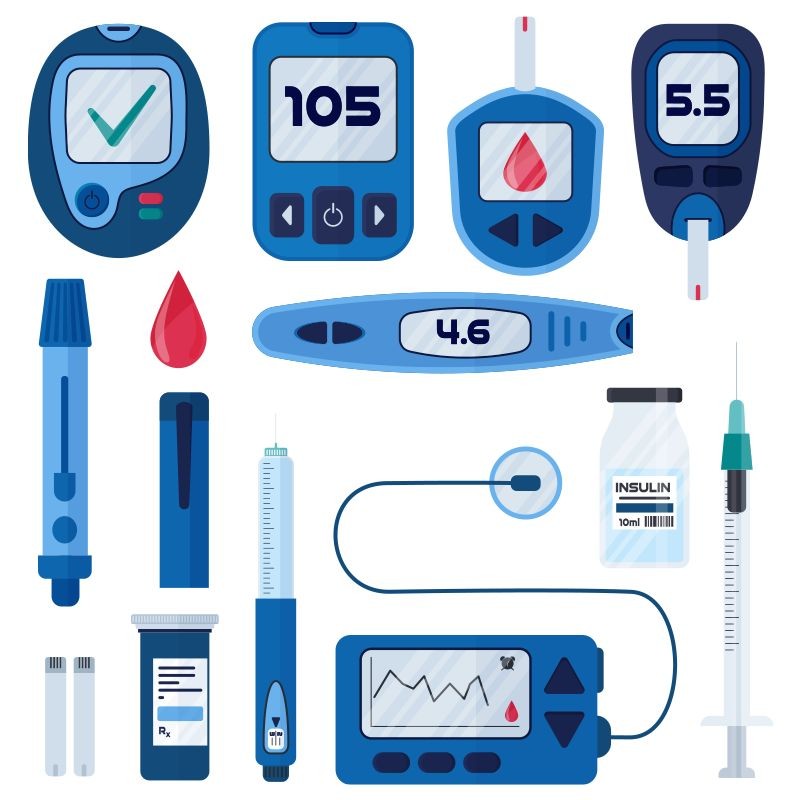
Contents
What Tools Are Used for Diabetes?
With advancements in medical science and technology, various methods have been developed to effectively, accurately, and conveniently manage blood sugar levels.
Six tools used for diabetes to measure blood sugar levels and keep diabetes in check:
6 tools used for diabetes
- Glucometer or glucose monitor, lancets, and test strips:
- Measures blood sugar levels using a small amount of blood at home.
- Provides valuable information about the impact of diet, exercise, stress, sickness, and medication on blood sugar levels.
- Easy to use and provides quick results.
- A lancet pricks the skin to obtain a blood sample, which is then dropped onto a disposable test strip.
- The strip is inserted into the monitor, which displays blood sugar levels in seconds.
- Insulin and syringes:
- Hormone produced by the pancreas to metabolize sugar in the body.
- Injected based on doctor’s prescription.
- Types include rapid-acting, regular or short-acting, intermediate-acting, and long-acting.
- Insulin pump or pens:
- Pens with prefilled cartridges or insertable cartridges that mimic natural insulin use.
- Pump attached to the waistband, connected to a catheter inserted under the skin, delivering insulin in programmed doses.
- Ketone test strips:
- Used to detect uncontrolled blood sugar levels by measuring ketones.
- Recommended for symptoms of high ketone levels.
- Strips dipped into a container with urine to compare color for ketone level indication.
- Glucose tablets:
- Important to manage blood sugar levels and prevent complications of hypoglycemia.
- Fast-acting sugar pills for low blood sugar levels.
- In cases of unconsciousness, a shot of glucagon may be needed.
- Diabetes medical alert bracelet:
- Used in emergency medical situations to provide important information.
Who should be tested for diabetes?
Regular testing allows for the early diagnosis and management of prediabetes, diabetes, and gestational diabetes to prevent complications.
Testing is recommended for those experiencing symptoms of diabetes or those with high-risk factors, such as:
- Aging
- Obesity
- Sedentary lifestyle
- Family history of diabetes
- Hormonal diseases
- Pancreatitis
- Certain medications
2 types of diabetes
- Type I diabetes:
- Most common in children and young adults.
- Caused by the immune system attacking and destroying insulin-producing beta cells.
- Factors such as genetics and viruses may contribute to its development.
- Type II diabetes:
- Most common in people over 40 years old and those who are overweight or physically inactive.
- Caused by a combination of genetic and lifestyle factors.
- Begins with insulin resistance and leads to increased blood glucose levels.
- Over time, the pancreas is unable to produce enough insulin.
QUESTION
What are the symptoms of diabetes?
Symptoms of type I diabetes can appear suddenly, while type II diabetes symptoms may develop slowly over time. Symptoms include:
- Increased thirst
- Increased frequency of urination
- Increased hunger
- Fatigue
- Blurred vision
- Numbness or tingling in the feet or hands
- Slow-healing sores
- Unexplained weight loss
What tests are used to diagnose diabetes?
The following tests are commonly used to diagnose diabetes:
- Fasting plasma glucose (FPG) test: Measures blood glucose levels after fasting for at least eight hours in the morning.
- Postprandial blood glucose test: Measures blood glucose levels two hours after a meal.
- Random plasma glucose test: Measures blood sugar levels at any time during the day without fasting.
- HbA1C test: Provides an average of blood glucose levels over the past three months.
- Oral glucose tolerance test: Measures blood glucose levels before and after consuming a glucose solution.
| Normal | Less than 5.7 | Less than 99 | Less than 139 |
| Prediabetes | 5.7 to 6.4 | 100 to 125 | 140 to 199 |
| Diabetes | More than or equal to 6.5 | More than 126 | 200 or above |
8 complications of diabetes
Complications of diabetes include:
- Heart diseases
- Stroke
- Kidney diseases
- Eye problems
- Dental issues
- Nerve damage
- Foot problems
- Frequent infections


